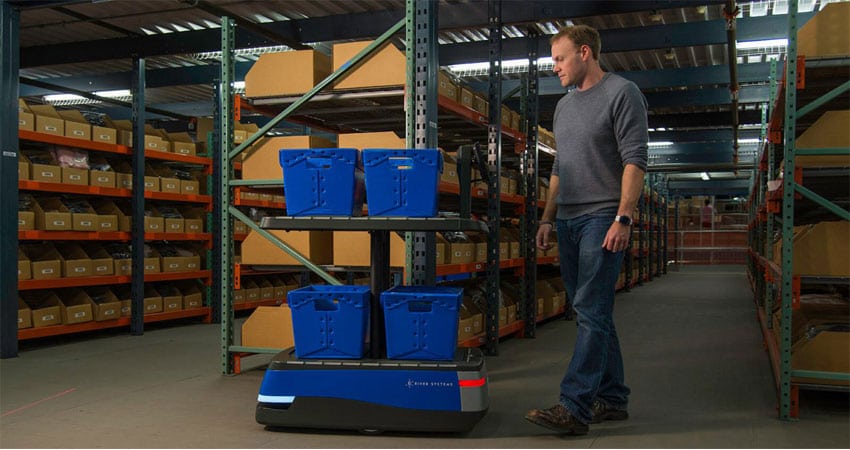Joining an ever-more-crowded group of robotics providers for ecommerce fulfillment, two former executives of Kiva Systems have built what they believe is a better mousetrap.
Jerome Dubois and Rylan Hamilton worked at Kiva when Amazon acquired the company in 2012 to automate its growing network of fulfillment centers; it was taken private two years later, leaving a void in the market. Addressing that need, Dubois and Hamilton co-founded 6 River Systems in 2015.
6 River’s technology, in the form of Chuck robots that work hand-in-glove with warehouse associates, came on the market in April. The company recently landed $15 million in new venture funding from Norwest Venture Partners, Eclipse Ventures and iRobot, the company behind the Roomba vacuum.
Essentially a self-driving cart, the Chuck has a display screen which shows associates where items to be picked are located and how many to pick at each stop, then directs them to the next location in their “pick path” of multiple orders. It can also be used for putaway, counting and sorting functions. Learning as it goes, the Chuck helps associates go through their tasks more efficiently.
Like competitors Fetch Robotics, inVia Robotics and Locus Robotics, 6 River Systems is positioning itself as a less expensive, mid-market alternative to full-blown automation hardware costing in the millions and requiring infrastructure changes. Dubois said 6 River can be up and running quickly and is fairly intuitive for users. Onboard sensors guide its navigation within centimeters of an item to be picked.
Dubois said the ratio of 6 River Systems robots to associates using the system is roughly 2:1, compared to 6-10 robots per associate with some competitors. He said one Chuck can handle from four to 20 orders simultaneously and supports up to 160 lbs.
“You could do different types of automation, such as conveyors, pick to light and unit sortation,” Dubois said. “Our system is meant to drop in as a replacement for what you’re already doing with carts. It’s designed from the ground up to need zero infrastructure – steel cable, wires or racking. And you don’t need a server on site as it uses cloud processing. The robots provide all the conveyance needed, with a scanner and workstation built in.”
A screen on the Chuck displays an associate’s performance during a shift, for example, and alerts them to how they’re doing against performance goals. 6 River’s software connects to warehouse systems like WMS to pull in data about incoming orders and product locations.
The robots become smarter over time, and can help operations managers identify areas for improvement, managing associate foot traffic and where inventory is located.
While he believes humans will be involved in ecommerce fulfillment for years to come, Dubois said he could see a day coming where autonomous platform-based robots combine with robotic grasping arms like those from RightHand Robotics to reach new levels of efficiency and productivity. This is already a critical need as ecommerce companies are finding it harder and harder to meet staffing requirements.
“Today (grasping arms) work well with conveyor systems and tote-to-tote, but not so well in a dark aisle where they’re choosing between dark jeans and a t-shirt in a mixed SKU bin,” he said. “But as grasping technology evolves, it will be attached to a mobile platform, bringing it to a location, grabbing an item and moving on, using stationary shelving.”

